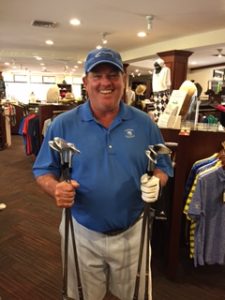Hi Bob. I keep a journal to reflect on and record what I learn in lessons. I just thought I would share my entry from Wednesday.
Wednesday 4/12: I watched Bob coach a very good amateur.
Coach introduced me to Dan Sivadge who he described as one of the best and most competitive amateur golfers in southern CA. This golfer said he hadn’t golfed in 3 months which was a longer break than he had ever taken in his life. He seemed a bit frustrated because he had lost control over his shot shape and lost his “feel” at impact.
He asked coach to look at his stance and ball position and swing. Bob took pictures of him at address with his 9, 6, and driver. Coach said there was nothing wrong with his set up or his swing. He would not give the golfer advice – saying it would be very bad to start “chasing geese” as the golfer regains familiarity with his swing.
Coach then asked the golfer the same question several times and wouldn’t let the golfer dodge it – “in the next 1000 balls, how many do you think you will mis-hit?” When the golfer finally said 20%, Bob said “well you’re gonna mis-hit more balls than you are used to in the next week and you just have to choose to be OK with that and trust and be patient that the % of mishits will go down as you start to practice more”. It would be a bad idea to start changing things while he is out of practice. Here I could see that the advice to “do nothing” because nothing needed to be “fixed” was invaluable.
Of course for Bob to be able to give this advice, he needed a trained pro eye to determine that there was indeed nothing “wrong” with the swing. That is to say, this is not general advice that can be given to by anyone advising an out-of-practice golfer – it still takes a pro’s eye to determine the swing is indeed in ok shape.
He then asked the golfer what he has done in the past to “get his swing back”. The gentleman said short game, because it allows him to practice feeling the swing at the impact position while taking a smaller swing.
Coach then watched him hit small PW shots for an hour. Coach noted the golfers pre shot routine got more consistent. Simultaneously the golfer started to hit a very consistent 80 yard shots with a draw that seemed to please the golfer.
Also, just after Bob complemented a particularly good sounding impact, the golfer said something very interesting. He said “Yeah I can do that, it’s just that right now I need to concentrate a little harder”.
Here is my opinion of what happened. The golfer was thinking that his errant shots were coming from some physical mistake when really it was all mental. The fact that the shots got better simultaneously with pre-shot routine shows that the golfer just needed to reestablish his relaxed concentration mental state where he could unconsciously perceive and control the impact condition. The golfer already knew and said that shot control came from club head awareness (mental – not physical) and that shorter swing shots were the way to rebuild that awareness or “feel”.
Interestingly Bob’s role here was to help connect the golfer with what Dan already knew was correct, and to steer the golfer away from getting distracted by physical “fixes”. Bob had to work very hard to remind the golfer of what he already knew by asking him thing like “When did your swing last feel good?” and “What did you do last time to get your swing back?”
I also liked how Bob would stand directly over the golfer’s ball to take control of the lesson and conversation.
Thank you Dan and Bob.
Will Stuart
